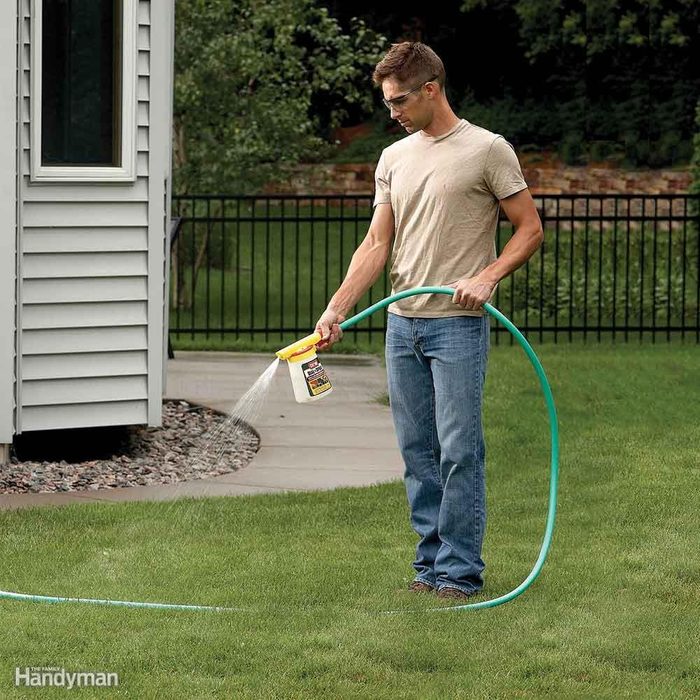1
/
12

How to Identify Ants
Start by identifying the type of ant in your house so you can find out how to get rid of ants, their nesting habits and have a better idea of where they're living (they may be nesting outdoors).
Take a close-up photo of the ant and send it to your local university extension service (enter your state's name and “university extension service” into any online search engine). The extension service will tell you the type of ant you're dealing with and where it nests. They may give you fact sheets about the ant species and maybe even some advice on getting rid of that particular ant species.
2
/
12

How to Find Ant Nests
Sometimes the solution to an ant problem is getting rid of their nest. If you're dealing with carpenter ants, which can do structural damage to your house, it's vital that you wipe them out ASAP. Finding the nest may not be easy and takes some detective work. Ants generally prefer damp areas, such as framing or flooring that's soft and spongy from a plumbing or roof leak. How to get rid of ants begins by looking for areas with water damage. Attics, bathrooms and exterior walls are obvious candidates.
Cut small holes in water-damaged walls to track down the ant nest. (You're going to have to repair the walls anyway.) When you find the nest, spray it with an insecticide that contains bifenthrin, permethrin or deltamethrin (look on the label). Ortho's Home Defense Max is one brand. Be sure to fix the water leak and replace damaged wood. If you can't track down the nest, hire a pest control service. Pros spend about 80 percent of their time hunting down nests. Their fees start at about $150, but tough cases with multiple treatments can cost $400 or more.
3
/
12

Ant Removal: Determine the Best Ant Bait
When you see an ant, your first impulse is probably to step on it. But don't. You'll kill it, but for every ant you see, there may be hundreds more hiding in the house. The ones you see are scout ants, foraging for food to take back to the colony. Use these scouts to wipe out the entire colony.
Prebait ants in areas you've previously seen them. Ants' tastes change during the year. They usually prefer protein in the spring and sweets or fatty/oily foods in the summer. Set out sugar or honey, fried food and peanut butter, then see which food attracts ants. Use whichever food they prefer for bait and a DIY way to get rid of ants.
Once you know what the ants like, buy and set out toxic ant bait that's geared to their taste. Look on the bait package for words like “controls both sweet and grease eating ants.” Stop ants from coming in the house by using this 'outdoor ant bait (Amazon)' around your yard.
4
/
12

Ant Removal: Erase Ant Trails
Where you see one ant, you're bound to see others. That's because ants leave a scented trail that other ants follow. Sweeping or mopping isn't enough to eliminate the scent. Instead, mix 1 part vinegar with 3 parts water in a spray bottle for a safe way to get rid of ants in the home, then spray wherever you've seen ants in the past. This will stop outdoor nesting ants that entered the house to forage for food (ants that come inside are not necessarily trying to establish a nest).
Vinegar and water won't stop ants that are already nesting indoors. You'll need to kill them with ant bait.
5
/
12

Ant Removal: Wipe Out Ant Colonies
Once you've set out toxic ant bait, expect to see lots of ants (initially). That's a good thing. It means more ants are taking the bait (which is toxic) back to the colony where they'll share it with the rest of the ants, including the queen, and kill them. There might be thousands of ants back at the nest.
Liquid bait is the best way to kill ants for many sweet-loving ants. Other ants prefer solid bait. If you still have ants in house after two weeks, replace the bait containers. If that doesn't work, how to get rid of ants next means finding the nest.
6
/
12

How to Kill Ants in Your Yard
Anthills are eyesores in yards, and the ants can ruin outside dining. If you only have ants in a certain area, like along your sidewalk, spot-treat the area with an outdoor insecticide. Liquid or granules work fine as a way to get rid of ants.
For large-scale ant problems on how to get rid of ants, use a lawn and garden insect killer that contains bifenthrin as the active ingredient. The spray will also kill other insects (read the label for a list).
- First, mow the grass.
- Then spray the insecticide on the entire lawn—you can also spray shrubs and trees.
7
/
12

How to Kill Ants in Your Yard: Destroy Exterior Nests
If you frequently see ants in the same area on the siding, there's probably an ant nest in there. How to get rid of ants begin with looking for holes in the siding where ants are crawling in and out. The holes are often located between bricks where mortar has fallen out, under lap siding or in cracks in stucco. Once you locate the nest, or the vicinity of the nest, spray the area with an insecticide containing bifenthrin.
Image courtesy of Mike Merchant, Texas A&M
8
/
12

How to Kill Ants in Your Yard: Fire Ants
Fire ants are found in the Southeastern United States and Southern California. Standard insecticides are much less effective at killing fire ants.
You need a special product that's designed to wipe out and the best wall to kill ants and these biting critters. Apply the granules with a broadcast spreader.
Fire ants carry the granules, which they think are food (it's actually toxic bait) back to their mounds. The ants share the bait and die. Some of these insecticides keep killing fire ants for up to a year. As with other baits, it may take a few weeks for you to see full results.
9
/
12

Ant Prevention: Keep It Clean
A clean house is your first defense against ants. Sweep up food crumbs, wipe up spills, take out the garbage and don't leave dirty dishes sitting around the house. This takes away the ants' food source. For a safe way to get rid of ants, spray vinegar mixed with water around bowls of pet food to keep ants from feasting there.
10
/
12

Ant Prevention: Spray Ant Entry Points
After ridding the house of ants, take steps to ensure they don't come back. Caulk and seal holes, and then spray insecticide around doors and windows. An insecticide that contains bifenthrin, permethrin or deltamethrin is one way how to get rid of ants. Spray a 4-in.-wide band along entry points, just enough to wet the surface.
Once dry, the spray leaves an invisible film that repels ants so they won't enter the house. Each spring, spray the insecticide to guard against ants. But keep in mind that this only works to keep ants out—it won't kill ants that are already inside, and it can actually interfere with the use of ant baits. Kill more than just ants with this multipurpose insect bait (Amazon), which is one of the best ant sprays.
11
/
12

Ant Prevention: Spray on an Ant Barrier
If you're still getting ants in your house after spraying interior entry points, spray a 12-in.-wide band of ant insecticide on the foundation and on and under the first course of lap siding to keep ants from entering the house. An outdoor insecticide that says “barrier treatment” on the label is one tool for how to get rid of ants.
12
/
12

Ant Prevention: Eliminate Safe Havens for Ants
Once you kill the ants in your house and yard, take steps to ensure they don't come back.
- Trim back bushes, shrubs and trees that brush against your siding or roof that provide a bridge for ants to reach your house.
- Keep a 3-in. to 6-in. clearance space between the soil around the foundation and the bottom row of siding to prevent ants from nesting in the siding (and make sure the soil slopes away from the house).
- Avoid stacking firewood next to the house. Firewood makes a perfect retreat for ants.
- Ants like bare spots in the yard and ants like to build nests under layers of thatch. Maintaining a healthy lawn is one way to get rid of ants.
- If anthills pop up in bare areas, spray the mound with insecticide and plant grass in the bare spots in order to get rid of ants.
- Rake the lawn or bag the grass when you mow to eliminate thatch.
Originally Published: July 03, 2019